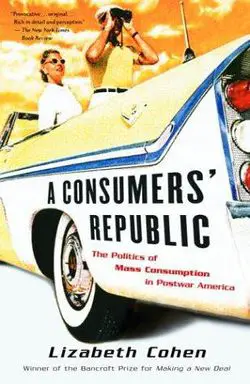A Consumers’ Republic - Book Review

This article was originally published on Videri.org and is republished here with their permission.
Liz Cohen’s second book serves as a beautiful companion piece to Alan Brinkley’s The End of Reform, which highlighted the New Dealers’ embrace of consumerism as the basis for liberal policy in the face of political reversals and persistent depression in the late 1930s. If the government cannot regulate business and labor to the benefit of all, it can at least put dollars in the citizens’ hands, to make them consumers and get the economy flowing. Consumers’ Republic takes this pattern through the postwar years and up to the present when conservatives have inaugurated a period of deregulation, privatization, and economic individualism.
In Cohen’s view, the New Deal idea of “the interests of consumers are the same as those of the nation” has been replaced by “what’s best for me is best for America.” In any case, the mantra of this period is “buy, buy, buy,” and Cohen insists that choices in the market were often politicized. Disney’s notorious miser, Scrooge McDuck, first appeared shortly after the war, along with the notion that “thrift is now un-American.”
So much of the mania for shopping emanated from the raw new horizon of American life, the Levittowns and other sprawling new communities built to house the baby-boom generation as quickly and cheaply as possible. Cohen focuses primarily on the biggest purchase most Americans made in this period – houses – and the appliances that filled them and the cars that traveled to and from them. Appropriately, the study looks longest at New Jersey to discover the origins of the dispersed, suburban marketplace of the late twentieth century.
At a slight remove from New York City, developers in towns like Paramus, NJ could offer the widest range of goods in a shopping center ringed by parking lots, supplanting the old “town square” or “Main Street” forms of shopping, as well as the dense landscape of a Manhattan-like central business district. As one wag noted, the mall in Paramus offered everything but a funeral parlor. There were, however, many problems with this abundant panorama:"Much the way suburban residential communities and shopping centers, originally conceived to be widely accessible new postwar spaces, became increasingly stratified by class and race as they targeted distinct populations, so too as the post-war era progressed did the mass market itself fracture into numerous constituent parts.”
The new spaces of consumption were more privatized then ever, as a citizen was free to express her views on the sidewalk of the small-town Main Street or even downtown Manhattan – however, in a big-box retail store or megamall, the individual shopper moved through a vast landscape that was more or less under private control. The benefits of the GI Bill and federal housing loans went disproportionately to white men, and black Americans sought to obtain equal rights as consumers during the civil rights movement, overturning racist housing policies and integrating lunch counters. Cohen quotes poet Amiri Baraka on the frustrated desires for consumption that partly fueled the Newark riots of the late 1960s: "Families worked together, carrying sofas and TVs collectively down the street. All the shit they saw on television that they had been hypnotized into wanting they finally had a chance to cop.”
Cohen also looks at consumer research and target marketing to explain how Americans were led to purchase so many things in such a large scale. Cohen offers an intriguing answer to the recurring question of how much choice consumers can have when the number of firms in a given industry shrinks due to consolidation and concentration. She argues that companies can break audiences down into demographics and tailor products to a certain lifestyle image, “mirroring” in the market the sort of diversity that is thought to exist in the population. As Alan Wolfe observes,“A handful of beer makers replaced many local and independent ones, but to mimic the diversity that they abolished they proceeded to market a variety of beers with different names appealing to different kinds of beer drinkers. The same happened with cars, breakfast cereals, laundry detergents, and even newspapers and television stations.”
Cohen lauds the reinvigorated consumer movement of the 1960s, which sought to protect people from unsafe products and curb industrial excesses like pollution. In a sense, this activism can be seen as limiting the range of options on the market, by questioning what levels of danger consumers may be subjected to or actively pursue. In any event, this surge of public concern seems to have reduced in strength by the late 1970s, when Jimmy Carter disdained Americans’ “worship of self-indulgence and consumption” and was promptly replaced by a GE spokesman who cut taxes.